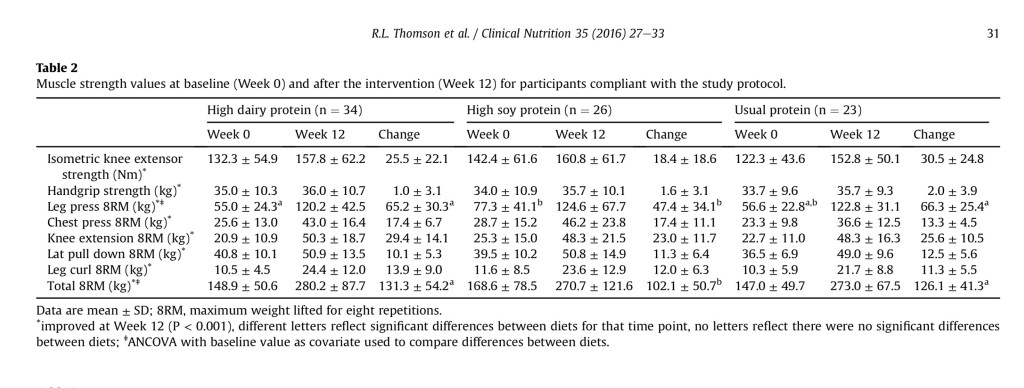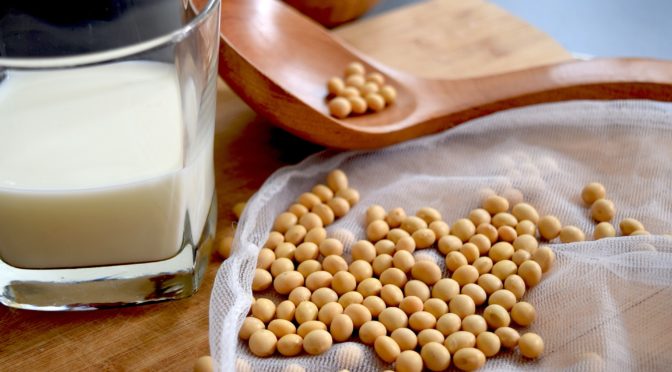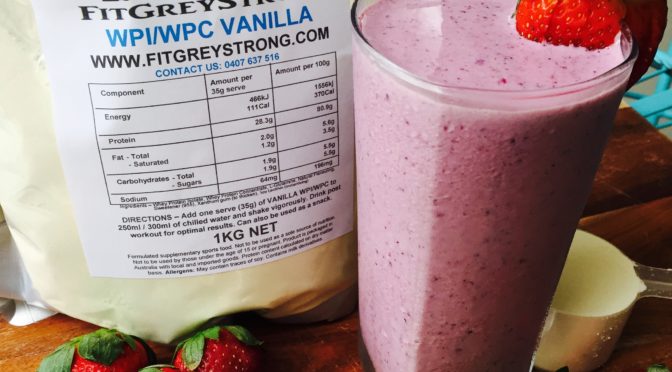Where Good Research Leads To Poor Interpretation
In my last research article review titled “Muscle strength gains during resistance exercise training are attenuated with soy compared with dairy or usual protein intake in older adults – part 1” (see here), no additional benefit for improvements in strength, body composition, physical function, or quality of life when additional protein from either dairy or soy versus usual protein intake were seen after 12 weeks of progressive resistance training exercise in healthy older adults.
The focus of this article – part 2 of this review – is to discuss the findings that suggest that increased soy protein intake attenuated improvements in muscular strength compared to dairy protein and usual protein. I want to explore some of the results of this study that are discordant with the conclusions reached by the authors. Their take-home message I believe is therefore misleading and misrepresents what the study actually showed.
The biggest problem with this is that the vast majority of media (print, TV, social media etc), websites, blogs and other avenues used to report on this study, haven’t taken the time to analyse or assess whether or not the conclusions reached are valid. In fact, when I Googled the net for websites, pages or blogs that wrote about, and reported the results of the study in question, I could not find ONE that had even questioned or scrutinised the conclusion against the actual results produced.
This highlights a bigger issue regarding the veracity of health, exercise, fitness and nutrition news that is reported and shared – following publication – in the blink of an eye. Whilst I do not want to explore this further today, it is certainly something that bothers me and something I would like to write about soon.
Let’s look at some of the issues with the conclusions reached by the authors of this paper.
Problem #1 – One of the main findings claimed to have been shown by this research was that:
Increased soy protein intake attenuated gains in muscle strength during resistance training in older adults compared with increased intake of dairy protein or usual protein intake” (pg. 27).
Now unless you read the whole study and scrutinised the results there would be no way of knowing if this conclusion is well-founded or not; so let’s have a look at the results table to see if this is a fair assessment of their data (click on table to expand).

The first thing you’ll notice is that the only exercise that soy protein attenuated gains in muscle strength was leg press 8RM (RM; maximum weight lifted for eight repetitions); for all other exercises no differences were found for protein source and subsequent strength improvement. More specifically, there were no significant differences between the soy, diary and usual protein group for strength improvement in isometric knee extensor strength, handgrip strength, chest press, knee extension, lat pulldown and leg curl. Thus, strength training adaptation from resistance training in older adults for all exercises, bar one (leg press), was the same irrespective of the protein source provided. The significant difference found therefore for the sum total 8RM lifted for all 8RM exercises was most likely due to the difference in leg press 8RM. (Note: percentage improvement in lat pulldown 8RM was greater in usual protein vs dairy but with no difference vs soy; this doesn’t, however, detract from the core proposal above).

If that is the case, the question that needs to be asked is, why was this ignored and not explored in the discussion? There are certainly some intriguing possibilities regarding this result. Does soy protein, for example, possibly attenutate gains in lower body but not upper body strength? Is there any other explanation for the attenuated strength for Leg press and, if so, would that mean that there are essentially no differences between the source of the protein and the strength improvement? I’m not sure what mechanism of action you would propose to explain a differential for strength gain between lower and upper body when consuming soy versus dairy protein? The authors do hypothesise that the inhibition of strength gain due to soy protein could have been hormonally based by stating:
Instead, it is more likely that the attenuation of the strength increase in the HP-S group was due to some effect of the soy inhibiting the increase in strength. Soy foods not only contain soy protein, but also contain isoflavones, which exhibit estrogenic properties [Barnes 2012]. A recent study demonstrated that 14 days of soy protein supplementation in resistance trained young men during training reduced serum testosterone concentrations in the first 30 min post-exercise compared with whey protein or a carbohydrate control [Kraemer et al. 2013]. It was proposed that this blunted serum testosterone response might reduce the anabolic response in skeletal muscle, thus attenuating the accretion of contractile protein and muscle strength gains. This may explain the attenuated increase in strength gains observed in the HP-S group in the present study (pg. 32).
However, I don’t think that the abovementioned soy-induced reduction in serum testosterone has been shown to affect muscle contractile properties in an appendicular specific manner (i.e. lower body responds differently to upper body). Moreover, in contrast to the authors proposition above, post-exercise testosterone response does not appear to correlate with, nor is it in any way indicative of subsequent strength gains following resistance training as shown, for example, by the work of Morton and colleagues (2016).
Problem #2: Assessing the results listed in table 2 for Leg Press highlights another interesting difference between the soy and dairy protein groups. The baseline strength values for the dairy and usual protein groups are significantly lower than the soy protein group (55.0 vs 77.3 vs 56.6). In fact, the 8RM baseline strength value for the soy protein group is approximately 40% higher than the other protein groups. Such a large difference would have been unexpected following randomisation with most other baseline values relatively comparable. How this difference affected the statistical analysis is difficult to say but I would have liked the authors to discuss this to put such a baseline disparity into perspective.
Given what was discussed in problem number 1, a separate statistical analysis should have been conducted on all 8RM exercises with leg press 8RM excluded. This assessment would have been able to tease out if the attenuated strength gain seen in the leg press also applied to the 4 other exercises. Based on the data for each individual exercise (excluding leg press), no differences were observed; however, there may have been insufficient power to detect any real differences. By grouping these 8RM exercises together this question could have been answered. As it stands, soy-induced strength gain attenuation can only be claimed for the 8RM leg press.

In relation to the training sessions, what is not particularly clear is whether the participants trained one-on-one with their instructor in solitude or whether the sessions involved small groups. It is feasible that if participants trained individually and at the same time but with different instructors, or in small mixed groups, those allocated to the dairy and usual protein experimental diets may have inadvertently or surreptitiously observed what the ‘stronger’ leg press soy participants were lifting and been incentivised to ‘push’ that bit harder in an attempt to bridge the gap.
Final comments: Based on the results of this study, I would have worded the conclusion very differently to that which was put to print by the Thomson et al. Something like the following would have probably been more apt:
Increased soy protein intake appeared to attenuate gains in leg press muscle strength only, compared with increased dairy protein or usual protein intake. With all other exercises there were no notable differences. Further research is required to explore the possibility that soy protein may specifically inhibit lower body strength gains from resistance training in older adults.
Post-script: Following further analysis and publication of part 2 of this blog, I wrote a letter to the Editor of Clinical Nutrition Journal outlining, what I believed, were some of the flaws regarding the interpretation of the results of this trial. Upon peer review this was accepted for publication and can be found here. If you are unable to access this correspondence and the authors reply to my letter, please contact me and I should be able to assist.
References
Barnes S. (2004) Soy isoflavones-phytoestrogens and what else? J Nutr 134:1225S-8S.
Cermak et al. (2012) Protein supplementaiton augments the adaptrive response of skeletal muscle to resistance-type exercise training: a meta-analysis Am J Clin Nutr 96: 1454- 64.
KraemerWJ et al. (2013) The effects of soy and whey protein supplementation on acute hormonal reponses to resistance exercise in men. J Am Coll Nutr 32:66-74.
Morton RW, Oikawa SY, Wavell CG, Mazara N, McGlory C, Quadrilatero J, et al. Neither load nor systemic hormones determine resistance training-mediated hypertrophy or strength gains in resistance-trained young men. J Appl Physiol July 1, 2016;121:129-138.
Thomson et al. (2016) Muscle strength gains during resistance exercise training are attenuated with soy compared with dairy or usual protein intake in older adults: A randomized controlled trial. Clinical Nutrition. 35: 27-33
Disclaimer: All contents of the FitGreyStrong website/blog are provided for information and education purposes only. Those interested in making changes to their exercise, lifestyle, dietary, supplement or medication regimens should consult a relevantly qualified and competent health care professional. Those who decide to apply or implement any of the information, advice, and/or recommendations on this website do so knowingly and at their own risk. The owner and any contributors to this site accept no responsibility or liability whatsoever for any harm caused, real or imagined, from the use or distribution of information found at FitGreyStrong. Please leave this site immediately if you, the reader, find any of these conditions not acceptable.
© FitGreyStrong



